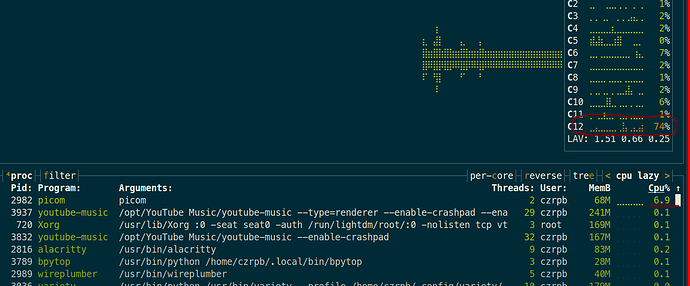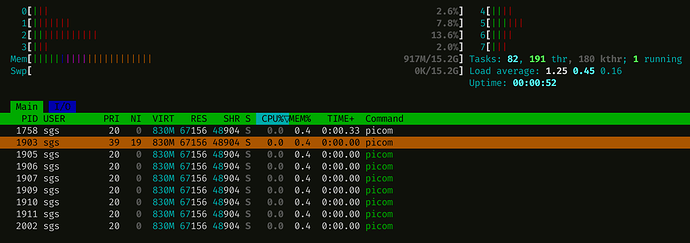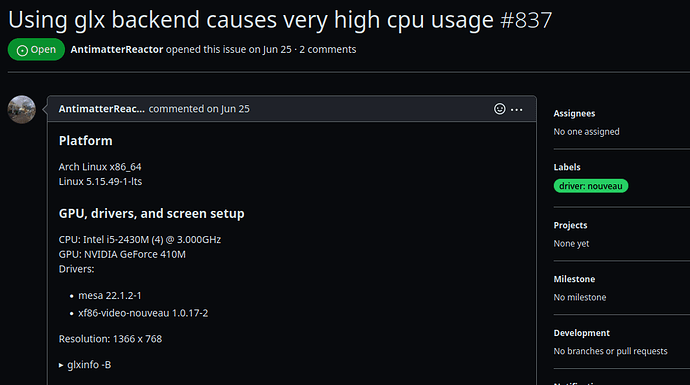Hi!
picom is using a lot of CPU and starts right up/away when logging in; it doesnt seem to wait for terminals or browsers etc.
Ive poke around the net and tried to turn off transparency/opacity in a couple of configs such as alacritty and picom, but still no go.
I do apologize for not being able to help myself and would be happy to have pointed out where I can improve!
garuda-inix
System:
Kernel: 6.0.12-zen1-1-zen arch: x86_64 bits: 64 compiler: gcc v: 12.2.0
parameters: BOOT_IMAGE=/@/boot/vmlinuz-linux-zen
root=UUID=641c7d0e-10b8-42e3-a23d-f70c816cb89a rw rootflags=subvol=@
quiet quiet splash rd.udev.log_priority=3 vt.global_cursor_default=0
loglevel=3 ibt=off
Desktop: i3 v: 4.21.1 info: i3bar vt: 7 dm: LightDM v: 1.32.0
Distro: Garuda Linux base: Arch Linux
Machine:
Type: Desktop Mobo: ASUSTeK model: TUF GAMING X570-PLUS (WI-FI) v: Rev X.0x
serial: <superuser required> UEFI: American Megatrends v: 2607
date: 08/14/2020
CPU:
Info: model: AMD Ryzen 5 3600 bits: 64 type: MT MCP arch: Zen 2 gen: 3
level: v3 note: check built: 2020-22 process: TSMC n7 (7nm)
family: 0x17 (23) model-id: 0x71 (113) stepping: 0 microcode: 0x8701021
Topology: cpus: 1x cores: 6 tpc: 2 threads: 12 smt: enabled cache:
L1: 384 KiB desc: d-6x32 KiB; i-6x32 KiB L2: 3 MiB desc: 6x512 KiB
L3: 32 MiB desc: 2x16 MiB
Speed (MHz): avg: 3748 high: 4116 min/max: 2200/4208 boost: enabled
scaling: driver: acpi-cpufreq governor: performance cores: 1: 4092 2: 3677
3: 4116 4: 3600 5: 3600 6: 3600 7: 3590 8: 3600 9: 3898 10: 4092 11: 3520
12: 3600 bogomips: 86230
Flags: avx avx2 ht lm nx pae sse sse2 sse3 sse4_1 sse4_2 sse4a ssse3 svm
Vulnerabilities:
Type: itlb_multihit status: Not affected
Type: l1tf status: Not affected
Type: mds status: Not affected
Type: meltdown status: Not affected
Type: mmio_stale_data status: Not affected
Type: retbleed mitigation: untrained return thunk; SMT enabled with STIBP
protection
Type: spec_store_bypass mitigation: Speculative Store Bypass disabled via
prctl
Type: spectre_v1 mitigation: usercopy/swapgs barriers and __user pointer
sanitization
Type: spectre_v2 mitigation: Retpolines, IBPB: conditional, STIBP:
always-on, RSB filling, PBRSB-eIBRS: Not affected
Type: srbds status: Not affected
Type: tsx_async_abort status: Not affected
Graphics:
Device-1: NVIDIA GM206 [GeForce GTX 960] vendor: Micro-Star MSI
driver: nouveau v: kernel alternate: nvidia_drm,nvidia non-free: 525.xx+
status: current (as of 2022-12) arch: Maxwell code: GMxxx
process: TSMC 28nm built: 2014-19 pcie: gen: 1 speed: 2.5 GT/s lanes: 16
link-max: gen: 3 speed: 8 GT/s ports: active: DP-3 empty: DP-1, DP-2,
DVI-I-1, HDMI-A-1 bus-ID: 09:00.0 chip-ID: 10de:1401 class-ID: 0300
temp: 35.0 C
Device-2: Anker PowerConf C300 type: USB driver: snd-usb-audio,uvcvideo
bus-ID: 3-4:5 chip-ID: 291a:3361 class-ID: 0e02 serial: <filter>
Display: x11 server: X.Org v: 21.1.4 compositor: Picom v: git-98a5c
driver: X: loaded: nouveau unloaded: modesetting alternate: fbdev,nv,vesa
dri: nouveau gpu: nouveau display-ID: :0 screens: 1
Screen-1: 0 s-res: 3440x1440 s-dpi: 96 s-size: 910x381mm (35.83x15.00")
s-diag: 987mm (38.84")
Monitor-1: DP-3 model: Samsung S34J55x serial: <filter> built: 2020
res: 3440x1440 dpi: 110 gamma: 1.2 size: 797x333mm (31.38x13.11")
diag: 864mm (34") modes: max: 3440x1440 min: 720x400
API: OpenGL v: 4.3 Mesa 22.2.3 renderer: NV126 direct render: Yes
Audio:
Device-1: NVIDIA GM206 High Definition Audio vendor: Micro-Star MSI
driver: snd_hda_intel bus-ID: 1-3:2 v: kernel pcie: chip-ID: 047f:c025
gen: 1 class-ID: 0300 speed: 2.5 GT/s serial: <filter> lanes: 16 link-max:
gen: 3 speed: 8 GT/s bus-ID: 09:00.1 chip-ID: 10de:0fba class-ID: 0403
Device-2: AMD Starship/Matisse HD Audio vendor: ASUSTeK
driver: snd_hda_intel v: kernel pcie: gen: 4 speed: 16 GT/s lanes: 16
bus-ID: 0b:00.4 chip-ID: 1022:1487 class-ID: 0403
Device-3: Plantronics Plantronics C320-M type: USB
driver: plantronics,snd-usb-audio,usbhid
Device-4: Anker PowerConf C300 type: USB driver: snd-usb-audio,uvcvideo
bus-ID: 3-4:5 chip-ID: 291a:3361 class-ID: 0e02 serial: <filter>
Sound API: ALSA v: k6.0.12-zen1-1-zen running: yes
Sound Server-1: PulseAudio v: 16.1 running: no
Sound Server-2: PipeWire v: 0.3.61 running: yes
Network:
Device-1: Intel Wireless-AC 9260 driver: iwlwifi v: kernel pcie: gen: 2
speed: 5 GT/s lanes: 1 bus-ID: 04:00.0 chip-ID: 8086:2526 class-ID: 0280
IF: wlp4s0 state: down mac: <filter>
Device-2: Realtek RTL8111/8168/8411 PCI Express Gigabit Ethernet
vendor: ASUSTeK driver: r8169 v: kernel pcie: gen: 1 speed: 2.5 GT/s
lanes: 1 port: f000 bus-ID: 05:00.0 chip-ID: 10ec:8168 class-ID: 0200
IF: enp5s0 state: up speed: 1000 Mbps duplex: full mac: <filter>
Bluetooth:
Device-1: Intel Wireless-AC 9260 Bluetooth Adapter type: USB driver: btusb
v: 0.8 bus-ID: 3-5:3 chip-ID: 8087:0025 class-ID: e001
Report: bt-adapter ID: hci0 rfk-id: 0 state: up address: <filter>
Drives:
Local Storage: total: 2.74 TiB used: 113.1 GiB (4.0%)
SMART Message: Required tool smartctl not installed. Check --recommends
ID-1: /dev/nvme0n1 maj-min: 259:0 vendor: Samsung
model: SSD 970 EVO Plus 1TB size: 931.51 GiB block-size: physical: 512 B
logical: 512 B speed: 31.6 Gb/s lanes: 4 type: SSD serial: <filter>
rev: 2B2QEXM7 temp: 38.9 C scheme: GPT
ID-2: /dev/sda maj-min: 8:0 vendor: Seagate model: ST2000DM008-2FR102
size: 1.82 TiB block-size: physical: 4096 B logical: 512 B speed: 6.0 Gb/s
type: HDD rpm: 7200 serial: <filter> rev: 0001 scheme: GPT
ID-3: /dev/sdb maj-min: 8:16 type: USB vendor: Kingston
model: DataTraveler 2.0 size: 7.22 GiB block-size: physical: 512 B
logical: 512 B type: N/A serial: <filter> rev: 1.00
Partition:
ID-1: / raw-size: 931.22 GiB size: 931.22 GiB (100.00%)
used: 50.9 GiB (5.5%) fs: btrfs dev: /dev/nvme0n1p2 maj-min: 259:2
ID-2: /boot/efi raw-size: 300 MiB size: 299.4 MiB (99.80%)
used: 608 KiB (0.2%) fs: vfat dev: /dev/nvme0n1p1 maj-min: 259:1
ID-3: /home raw-size: 931.22 GiB size: 931.22 GiB (100.00%)
used: 50.9 GiB (5.5%) fs: btrfs dev: /dev/nvme0n1p2 maj-min: 259:2
ID-4: /var/log raw-size: 931.22 GiB size: 931.22 GiB (100.00%)
used: 50.9 GiB (5.5%) fs: btrfs dev: /dev/nvme0n1p2 maj-min: 259:2
ID-5: /var/tmp raw-size: 931.22 GiB size: 931.22 GiB (100.00%)
used: 50.9 GiB (5.5%) fs: btrfs dev: /dev/nvme0n1p2 maj-min: 259:2
Swap:
Kernel: swappiness: 133 (default 60) cache-pressure: 100 (default)
ID-1: swap-1 type: zram size: 31.26 GiB used: 2 MiB (0.0%) priority: 100
dev: /dev/zram0
Sensors:
System Temperatures: cpu: 68.1 C mobo: N/A gpu: nouveau temp: 35.0 C
Fan Speeds (RPM): N/A gpu: nouveau fan: 875
Info:
Processes: 382 Uptime: 51m wakeups: 0 Memory: 31.26 GiB
used: 6.11 GiB (19.5%) Init: systemd v: 252 default: graphical
tool: systemctl Compilers: gcc: 12.2.0 Packages: pm: pacman pkgs: 1514
libs: 381 tools: pamac,paru Shell: Zsh v: 5.9 running-in: alacritty
inxi: 3.3.24
e[1;34mGaruda (2.6.10-1):e[0m
e[1;34m System install date:e[0m 2022-09-11
e[1;34m Last full system update:e[0m 2022-12-12 e[1;31m↻
e[1;34m Is partially upgraded: e[0m No
e[1;34m Relevant software: e[0m NetworkManager
e[1;34m Windows dual boot: e[0m No/Undetected
e[1;34m Snapshots: e[0m Snapper
e[1;34m Failed units: e[0m
Thanks! << q




